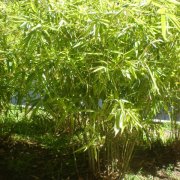Care of the shrub Phyllostachys aurea or Golden bamboo |
|
The genus Phylica, family Rhamnaceae, comprises 150 species of evergreen shrubs native to southern Africa. Some species are: Phylica plumosa, Phylica ericoides, Phylica paniculata, Phylica arborea, Phylica vulgaris. Common names: Golden bamboo, Fishpole bamboo, Fairyland bamboo, Monk's belly bamboo. This species is native to China. They are evergreen shrubs that reach 10 meters (32.8 feet) in height. The trunk sprouts from creeping rhizomes and is edible when sprouting. They have elongated leaves that appear on flexible stems. They don't usually bloom; after flowering the plant dies. Golden bamboo is used to form groups, to form hedges and barriers and in pots for terraces and patios. Phyllostachys aurea can grow in shade, semi-shade, and full sun exposures. It resists frost down to -10 ºC (14 ºF). It's ideal for coastal gardens because it resists ocean winds. The soil must be well drained and contain abundant organic matter. The transplant is done in spring. Water abundantly in summer so that the roots never dry out, but without flooding them. Wait for the substrate surface to dry before watering again. Fertilize in autumn with manure, with humus or with compost. Fishpole bamboo does not need pruning but its expansion must be controlled from the rhizomes because they tend to become invasive. Phyllostachys aurea is a plant resistant to pests but sensitive to excess moisture. Golden bamboo is propagated by division of rhizomes in early spring. |
Images of the shrub Phyllostachys aurea or Golden bamboo |
Find plants
Phyllostachys aurea or Golden bamboo | Care and Growing
© 2025 FavThemes


